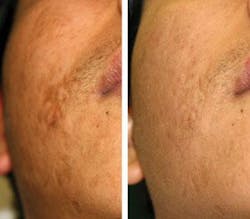Ed. Note:At the American Academy of Dermatology meeting in San Antonio, TX, in February 2008, at least eight companies exhibited fractional laser systems, both erbium and the newer CO2 models. BioOptics World previously profiled Reliant Technologies’ Fraxel re:pair system (see “Battle of the fractionals heats up in dermatology,” March/April 2008, p. 17); future issues will profile competing systems and technologies.
Lasering USA (San Ramon, CA) knows it is a little fish in a big pond when it comes to the skin rejuvenation market, but the company is confident that its technology—originally developed in Italy—will set it apart.
Lasering’s MiXto SX 10.6-µm CO2 laser system offers “microspot” technology combined with a high-speed scanner to deliver 0.3 mm spots in continuous-wave mode. According to the company—a joint venture between Lasering (Modena, Italy) and Transamerican Technologies International (TTI), a medical laser company established in 1984—other CO2 fractional lasers deliver larger (1.3 mm) spots in super-pulse mode with random distribution, which requires some form of anesthesia or tissue cooling. As described by Lasering, the MiXto’s microspot matrix, driven by a proprietary scanning algorithm, increases the interval between adjacent spots, minimizing heat accumulation around the treated area and, thus, pain during the procedure. In addition, the lower level of thermal burn permits quicker recovery.
Treatment of scars (before, left; after, right), heavy lines and wrinkles with Lasering USA’s MiXto SX Fractional CO2 shows immediate results, and causes an increase of collagen production for gradual secondary tightening from the dermis up.
“The technology came from Italy,” says Kelli Young, Lasering’s VP of Marketing. “Dante Marche is the engineer who designed and developed the MiXto SX. He created a patented computer-generated algorithm that delivers microspots of 300 µm, which means the laser only treats 20% of the skin at each pass in a z-shape pattern. Combined with the small spot size, this is why the patient feels much less discomfort. The system treats only 20% of the skin at one time with each pass, and there is time for the skin to cool in between each time the pattern is laid down.”
Three targets, one approach
In addition to general aesthetic treatments, such as the removal of wrinkles and sun spots, the company is focusing on three patient groups: younger people with acne scarring, older people with history of sun damage, and those with skin cancer lesions. According to Young, a full treatment of the face takes about 30 minutes and requires little to no anesthesia.
“If you talk to the other fractional companies, everyone is touting their efficacy, but compared to what?” Young says. “Going deep is not the answer to getting a good result. Going deep means longer healing time. CO2 laser treatments are all about the thermotherapy—that is, how much damage is done to the underlying collagen. When you damage the underlying collagen, you are stimulating growth. And because the MiXto operates in continuous wave mode, it penetrates sideways underneath the skin rather than going deeper. So we are doing the ablation on the outside 20% of the skin, but also doing thermotherapy under the skin. This means only one treatment is required, compared to three with many of the competing systems, and only foour to five days of down time.”
The MiXto sells for about $70,000, compared to $90,000 to $100,000 for competing CO2 fractional systems. Clinical studies are ongoing. – KK
